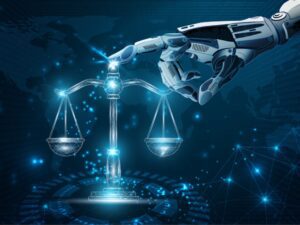The Fourth Industrial Revolution: Legal Issues Around Blockchain
By Louis Lehot
November 30, 2020

Louis Lehot is the founder of L2 Counsel, a boutique law firm based in Silicon Valley. He is a corporate, securities and M&A lawyer, and was formerly the co-managing partner of DLA Piper’s Silicon Valley office and co-chair of its venture capital and emerging growth company team.
Published in Today’s General Counsel, December 2020
Although most of blockchain’s success over the past decade has been linked to crypto-currencies, distributed ledger technology is poised to move into mainstream applications. As we adapt to a long-term period of social distancing, the paradigm in which technology evolves has been upended, and every member of society has had to quickly find new technology-based solutions to accomplish tasks previously taken for granted. In the coming decade, technology will shift from automating and replacing manual labor to replacing routine cognitive work, and blockchain is poised to be a key driver of the “fourth industrial revolution.”
The paradigm shift into the “fourth industrial revolution” was first postulated by Klaus Schwab in a 2015 article published by Foreign Affairs. It references evolution in the way we live, work and relate to one another, enabled by extraordinary technology advances. According to Schwab, these advances are merging the physical, digital and biological worlds. The social distancing measures required to respond to the global pandemic has put this fourth industrial revolution into overdrive.
WHAT IS BLOCKCHAIN?
Simply put, blockchain involves recording information in a way that creates trust in the data recorded. Blockchain is proof that you own something digital — whether it is a bitcoin or your personal health records. Blockchain proves you are the owner of whatever digital information you have on the distributed, decentralized public ledger. Estimates suggest that blockchain technology has been adopted by more than one-third of the world’s companies.
A blockchain can be trusted as a source of truth. Suppose certain information (data) was included in the blockchain sometime in the past but may not be correct. Records on the blockchain are immutable and provide an unalterable trail. A mistake can only be corrected by adding another block to the chain with consent from all participants. A blockchain records tangible and intangible assets among a network of peers that use the same software, algorithms and cryptography to maintain the records.
Currently, there are two types of blockchain: permissionless (public) and permissioned (private). Participants use pseudonyms to protect their identity with permissionless blockchains, and there is no identification of participants. Permissioned blockchains are protected by access privileges. Participants are authenticated, and a super-user may control the network.
Permissionless blockchains are considered more reliable because of the consensus principle. Blockchain currently enables many uses, including tokenization to protect sensitive data, unalterable timestamping, transfer of assets through a payment channel, and facilitation of smart contracts.
By 2023, the global blockchain market is set to reach $20 billion plus. The most prominent and influential companies worldwide have all turned their attention toward blockchain. Tech giants are investing billions, and Wall Street wants in, too. What makes blockchain so attractive to business?
First and foremost, it reduces operational costs by obviating the need for a centralized authority. Removing intermediaries is crucial for business because it reduces costs and points of contact, improving company efficiency and growth. Blockchain’s adoption will reduce costs of personnel, support, operations, IT, data breaches and much more.
In addition to blockchain’s efficiencies and security, it allows for the completion of transactions in seconds rather than days. Transaction speed is especially important in international interchanges.
LEGAL ISSUES
Stakeholders in blockchain solutions will need to ensure that their products comply with a legal and regulatory framework that was not conceived with this technology in mind. From a commercial law standpoint, smart contracts must be contemplated for negotiation, execution and administration on a blockchain, and in a legal and compliant fashion. Liability needs to be addressed. What if the contract has been miscoded? What if it does not achieve the parties’ intent? The parties must also agree on applicable law, jurisdiction, proper governance, dispute resolution, privacy and more.
There are public policy concerns that should be taken into account in shaping new laws, rules and regulations. For example, permissionless blockchains can be used for illegal purposes such as money laundering or circumventing competition laws. Also, participants may be exposed to irresponsible actions on the part of the “miners” who create new blocks. Unfortunately, there aren’t any current legal remedies for addressing corrupt miners.
As lawyers and technologists ponder these issues, several solutions are being bandied about. One possible remedy involves a hybrid of permissioned and permissionless blockchains. Some transactions require intervention by a responsible party, such as when Know Your Client (KYC) regulations are in play. All participants in blockchains and smart contracts where data is exchanged are data controllers. This means participants must comply with all data protection requirements.
Another consideration is what goes on the chain and what goes in the smart contract and off-chain. Although it is possible to include provisions regarding liability, jurisdiction and other legal aspects in the smart contract, this allows no room for interpretation because it is based on conditions. A better solution may be to have a real contract stored off the chain but linked to it with a hash-secure value for added confidence.
The ongoing regulatory push for more data with trends such as controlled free trade, increased border security and accreditation of economic operators leads to higher compliance costs. This means that parties trading globally need higher supply chain visibility and security. Data that is both high quality and secure, and trade compliance systems that can cope with the electronic exchange of data, are requirements.
Global trade involves many parties beyond the buyer and seller — customs and regulatory authorities, financial institutions, shippers, brokers and insurers. There are multiple exchanges of data among those participants, presenting opportunities for implementing a blockchain to trigger and record invoices, bills of lading and customs compliance.
As blockchain technology matures, global trade supply chains will increasingly use the technology, with the authorities monitoring transactions and compliance with customs declarations, duty payments and sanctions rules. Further, combining blockchain with the Internet of Things (IoT) will give manufacturers the ability to track products, manage risk in distribution networks and demonstrate good corporate governance.
Although no one can predict the future, it seems clear that blockchain will play an important role.
Must read intelligence for general counsel
Subscribe to the Daily Updates newsletter to be at the forefront of best practices and the latest legal news.
Daily Updates
Sign up for our free daily newsletter for the latest news and business legal developments.




